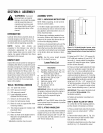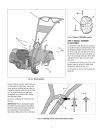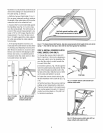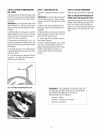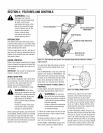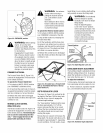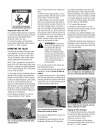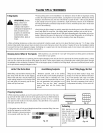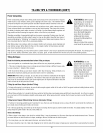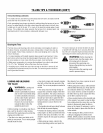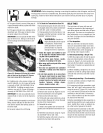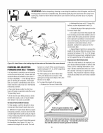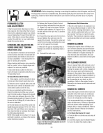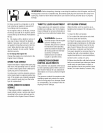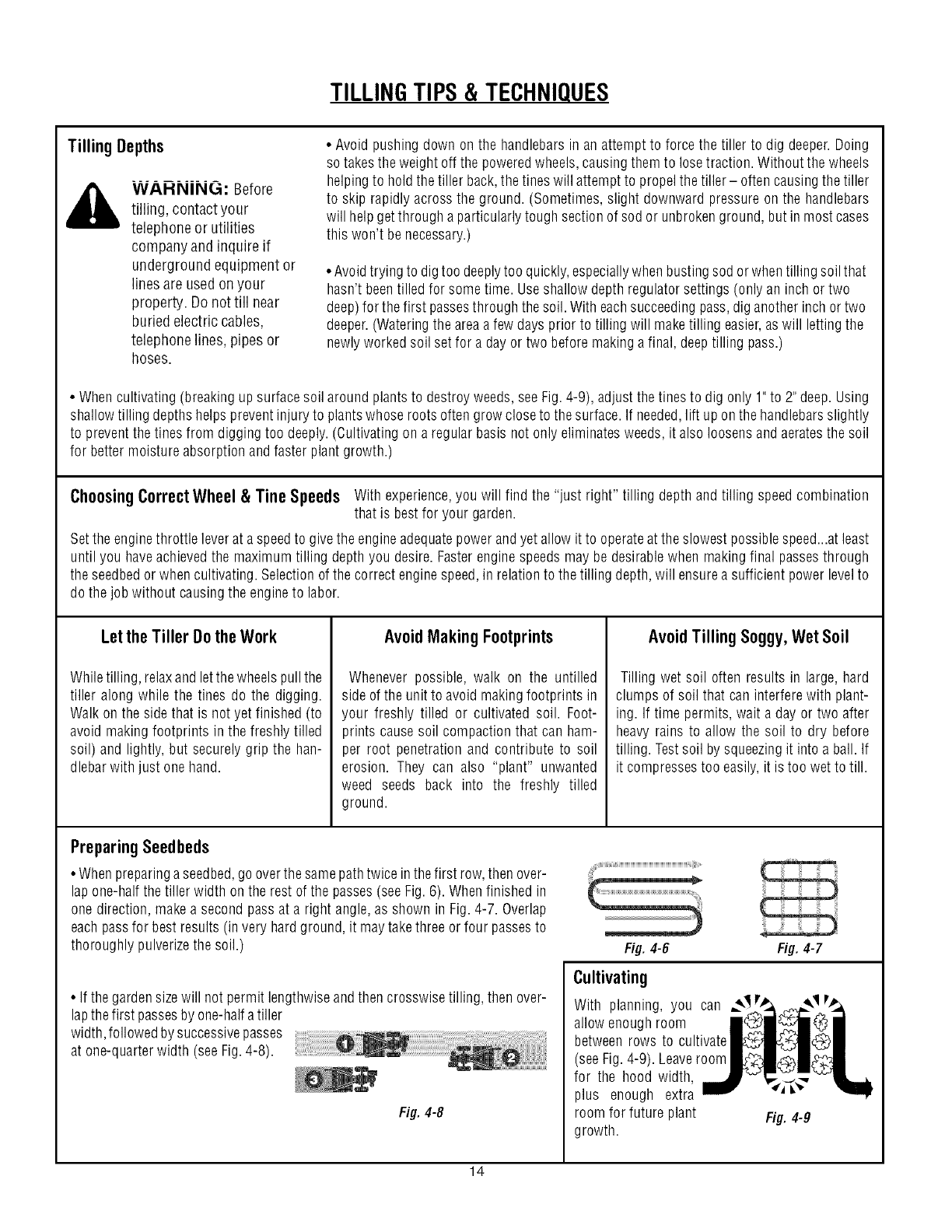
TILLINGTIPS & TECHNIQUES
Tilling Depths
WAHNINL_: Before
tilling, contact your
telephoneor utilities
companyand inquire if
undergroundequipment or
lines are usedon your
property. Donottill near
buriedelectric cables,
telephonelines, pipesor
hoses.
• Avoidpushingdown on thehandlebarsinan attemptto forcethe tiller to dig deeper.Doing
sotakestheweightoff thepoweredwheels,causingthemto losetraction.Withoutthewheels
helpingto holdthe tiller back,the tineswill attemptto propelthetiller- oftencausingthetiller
to skip rapidly acrosstheground. (Sometimes,slight downwardpressureonthe handlebars
will helpgetthrough a particularlytoughsectionof sod or unbrokenground,butin mostcases
this won't benecessary.)
• Avoidtrying todigtoo deeplytoo quickly,especiallywhenbustingsodorwhentilling soil that
hasn'tbeentilledfor sometime.Useshallowdepth regulatorsettings(only an inchor two
deep)for thefirst passesthrough thesoil.Witheachsucceedingpass,diganotherinchortwo
deeper.(Wateringthe areaafew daysprior to tilling will maketilling easier,aswill lettingthe
newlyworkedsoil setfor a dayor two beforemakinga final, deeptilling pass.)
• Whencultivating(breakingup surfacesoil aroundplantsto destroyweeds,seeFig.4-9), adjustthetinesto dig only1"to 2" deep.Using
shallowtilling depthshelpspreventinjury toplantswhose rootsoftengrowclosetothesurface.If needed,lift up onthehandlebarsslightly
to preventthetinesfrom diggingtoo deeply.(Cultivatingon a regularbasisnotonlyeliminatesweeds,it alsoloosensandaeratesthesoil
for bettermoistureabsorptionandfaster plantgrowth.)
ChoosingCorrectWheel& TineSpeeds With experience,you will find the "just right" tilling depthandtilling speedcombination
that is bestfor your garden.
Settheenginethrottleleverata speedto givetheengineadequatepowerandyetallowit to operateat the slowestpossiblespeed...atleast
until youhaveachievedthe maximumtilling depth you desire.Fasterenginespeedsmaybe desirablewhen makingfinal passesthrough
theseedbedor whencultivating. Selectionofthecorrect enginespeed,in relationtothetilling depth,will ensurea sufficientpowerlevelto
do thejobwithout causingthe engineto labor.
Letthe Tiller Dothe Work
Whiletilling, relaxandletthewheelspullthe
tiller alongwhile the tines do the digging.
Walkon theside that is notyet finished(to
avoidmakingfootprints in thefreshlytilled
soil) and lightly,but securelygrip the han-
dlebarwith just onehand.
AvoidMakingFootprints
Wheneverpossible, walk on the untilled
sideoftheunit to avoidmakingfootprints in
your freshly tilled or cultivated soil. Foot-
prints causesoil compactionthat can ham-
per root penetrationand contribute to soil
erosion. They can also "plant" unwanted
weed seeds back into the freshly tilled
ground.
AvoidTilling Soggy,Wet Soil
Tilling wet soil often resultsin large,hard
clumpsof soil that caninterferewith plant-
ing.If time permits,wait a dayor two after
heavyrainsto allow the soil to dry before
tilling. Testsoil by squeezingit intoa ball.If
itcompressestoo easily,it is toowet totill.
Preparing Seedbeds
• Whenpreparingaseedbed,go overthesamepathtwiceinthefirst row,then over-
lapone-halfthetiller width onthe rest ofthepasses(seeFig.6).Whenfinishedin
onedirection,makea secondpassat a rightangle,as shownin Fig.4-7. Overlap
eachpassfor best results(invery hardground,it maytakethree or four passesto
thoroughlypulverizethe soil.)
• If the gardensizewill not permitlengthwiseandthencrosswisetilling, thenover-
lapthefirst passesby one-halfatiller
width,followedbysuccessivepasses ....................v .................................
at one-quarterwidth (seeFig.4-8). _ _
Fig. 4-8
Fig. 4-6 Fig. 4-7
Cultivating
With planning, you can ==.._vp. ==_._v_
allow enoughroom _" _ (_
betweenrows to cultivate _ _
(seeFig.4-9). Leaveroom _ _
for the hood width,
plus enough extra _ _'_'
roomfor future plant Fig.4-9
growth.
14



